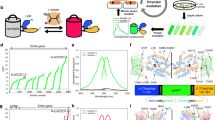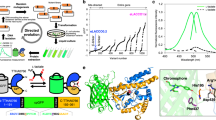Abstract
Lactate, the product of aerobic glycolysis, plays a dual role as fuel and intercellular signal in inflammation, immune evasion, and tumor progression. The production of lactate by macrophages has been associated with their polarization and function. Here we describe imaging protocols to characterize the metabolism of cultured human macrophages using a genetically encoded fluorescent sensor-specific for lactate. By superfusing cultures with increasing lactate concentrations and pharmacological inhibitors, it is possible to estimate the kinetic parameters of monocarboxylate transporter 4 (MCT4) and lactate production. Practical advice is given regarding sensor expression, imaging, and data analysis. The spatiotemporal resolution of this technique is amenable to the study of fast events at the single-cell level in different immune and other cell types.
Access this chapter
Tax calculation will be finalised at checkout
Purchases are for personal use only
Similar content being viewed by others
References
Barros LF, Ruminot I, San Martín A, Lerchundi R, Fernández-Moncada I, Baeza-Lehnert F (2019) Aerobic glycolysis in the brain: Warburg and Crabtree contra Pasteur. Neurochem Res. https://doi.org/10.1007/s11064-020-02964-w
Brooks GA (2009) Cell-cell and intracellular lactate shuttles. J Physiol 587(Pt 23):5591–5600
Magistretti PJ, Allaman I (2018) Lactate in the brain: from metabolic end-product to signalling molecule. Nat Rev Neurosci 19(4):235–249
Barros LF, Weber B (2018) CrossTalk proposal: an important astrocyte-to-neuron lactate shuttle couples neuronal activity to glucose utilisation in the brain. J Physiol 596(3):347–350
Ahmed K, Tunaru S, Tang C, Muller M, Gille A, Sassmann A et al (2010) An autocrine lactate loop mediates insulin-dependent inhibition of lipolysis through GPR81. Cell Metab 11(4):311–319
Barros LF (2013) Metabolic signaling by lactate in the brain. Trends Neurosci 36(7):396–404
Liberti MV, Locasale JW (2016) Correction to: ‘The Warburg effect: how does it benefit cancer cells?’: [Trends in Biochemical Sciences, 41 (2016) 211]. Trends Biochem Sci 41(3):287
Haas R, Cucchi D, Smith J, Pucino V, Macdougall CE, Mauro C (2016) Intermediates of metabolism: from bystanders to signalling molecules. Trends Biochem Sci 41(5):460–471
Depaoli MR, Bischof H, Eroglu E, Burgstaller S, Ramadani-Muja J, Rauter T et al (2019) Live cell imaging of signaling and metabolic activities. Pharmacol Ther 202:98–119
San Martín A, Ceballo S, Ruminot I, Lerchundi R, Frommer WB, Barros LF (2013) A genetically encoded FRET lactate sensor and its use to detect the Warburg effect in single cancer cells. PLoS One 8(2):e57712
Xu R, Li C, Wu Y, Shen L, Ma J, Qian J, Ge J (2017) Role of KCa3.1 channels in macrophage polarization and its relevance in atherosclerotic plaque instability. Arterioscler Thromb Vasc Biol 37(2):226–236
Machler P, Wyss MT, Elsayed M, Stobart J, Gutierrez R, von Faber-Castell A et al (2016) In vivo evidence for a lactate gradient from astrocytes to neurons. Cell Metab 23(1):94–102
Contreras-Baeza Y, Ceballo S, Arce-Molina R, Sandoval PY, Alegr K, Barros LF et al (2019a) MitoToxy assay: a novel cell-based method for the assessment of metabolic toxicity in a multiwell plate format using a lactate FRET nanosensor, laconic. bioRxiv:583096
Contreras-Baeza Y, Sandoval PY, Alarc R, Galaz A, Cort-Molina F, Alegr K et al (2019b) MCT4 is a high affinity transporter capable of exporting lactate in high-lactate environments. bioRxiv:586966
Miyawaki A, Griesbeck O, Heim R, Tsien RY (1999) Dynamic and quantitative Ca2+ measurements using improved cameleons. Proc Natl Acad Sci U S A 96(5):2135–2140
Acknowledgments
We thank Karen Everett for reading the manuscript. The Centro de Estudios Científicos (CECs) is funded by the Chilean Government through the Centers of Excellence Basal Financing Program of CONICYT.
Author information
Authors and Affiliations
Corresponding authors
Editor information
Editors and Affiliations
Rights and permissions
Copyright information
© 2020 Springer Science+Business Media, LLC, part of Springer Nature
About this protocol
Cite this protocol
Baeza-Lehnert, F., Flores, C.A., Guequén, A., Barros, L.F. (2020). Monitoring Lactate Dynamics in Individual Macrophages with a Genetically Encoded Probe. In: Mishra, S. (eds) Immunometabolism. Methods in Molecular Biology, vol 2184. Humana, New York, NY. https://doi.org/10.1007/978-1-0716-0802-9_2
Download citation
DOI: https://doi.org/10.1007/978-1-0716-0802-9_2
Published:
Publisher Name: Humana, New York, NY
Print ISBN: 978-1-0716-0801-2
Online ISBN: 978-1-0716-0802-9
eBook Packages: Springer Protocols




